|
||||||
In 1802 Elzy Burroughs had just completed building the Old Point Comfort lighthouse and was aware of the need to build another to the North. He acquired then sold 2 acres of land at New Point to the Federal Government with the understanding that he would be awarded the contract to build the lighthouse and keepers dwelling. Burroughs was a stone mason by trade, and his proposal to build was submitted hand written without drafted plans or drawings, and based primarily from his experience of building the Old Point Light. The proposal stated: "The light house to be of hewn faced stones; the form to be octagon. The foundation to be sunk 4 feet below the surface of the ground, or whatever greater depth may be sufficient to render the whole perfectly secure from the commencement of the foundation to the bottom of the water table" . . . He continues in elaborate detail explaining how the tower would be 50 feet in height, tapering from a diameter of 20 feet at the base to 12 feet at its top. The walls were to diminish in thickness from 5 feet to 2 feet respectively. A final note at the end - "I agree also to put down four stones for landmarks lettered U. S. to designate the boundaries of the public land, and to paint the lantern with three coats at my own cost without any additional charge," is a testament to his character and dedication to the project. The building plan remained a mere memory of his mind for 77 years until it was finally drafted from dimensions taken on-site by John Lewis in March, 1882.
Not much is known about the events that took place during the four long years Burroughs and his crew spent building the structures. How were the tons of materials delivered, by numerous wagon trips across the the soft sand, or were they brought by large shallow draft vessels and carried ashore by hand? New Point Comfort is a narrow finger peninsula with soft sandy beaches to the East, an impenetrable forest in the middle, and a large salt marsh to the the West. The idyllic beauty of the area can be deceiving. "Conditions there can be harsh and at times adverse to human habitation." Two hurricanes did pass northeast along the Atlantic Seaboard in August 1803 and September 1804 producing violent gales upon the lower Chesapeake. Another, in October 1804 passed directly over the Chesapeake Bay with Force 6 winds before turning nontropical and tracking northward dumping over two feet of snow in New England. Burroughs most likely rode this storm out on the mainland and returned after it had passed. They also had to endure the conditions that existed beside a thriving salt marsh habitat. "It is home to a variety of aggressive stinging and flesh-eating insects that prey upon their human host. Vast numbers of gnats can erupt from the swamp on still mornings and nights graying the sky in a swarming cloud. They burrow under the clothing and into the hair on the head. There is also a species of mosquito, larger than average, that can walk upon the skin undetected before it strikes. Biting flies in great variety prey here, some growing to several inches in length. They buzz about the head relentlessly before biting with such voracity as to cause a person to lose their grip or drop what they are carrying in order to swat at the beast."
Ships heading North up the Chesapeake Bay from the Atlantic Ocean or Hampton Roads now eagerly searched the horizon for New Point Comfort Light. Once found, it was given wide berth to port. The light also guided ships southward from the Piankatank River, or to and from the York River and Mobjack Bay to the West.
Since the lighthouse was built, it has steadfastly withstood the relentless forces of the wind and waves. The sandy beaches on which it stands have not held up as well. In 1847, a succession of strong Nor'easters began to carve out an inlet in the beach near the lighthouse. By 1852 the tip of the peninsula was cut off by the sea and the lighthouse and dwelling now stood on a new island. In 1855 a fixed 4th order light was refitted. In that year a report from the newly formed Light House Board states: "The illuminating apparatus is in very bad condition, being old and almost worn out. The repairs needed to the dwelling will be made on the first opportunity. The light should illuminate the whole horizon." During the Civil War the lighthouse was damaged and made inoperative by Confederate guerrillas in an attempt to disrupt Union shipping on the Chesapeake. After the war a report in 1865 indicated that the station required extensive repairs involving much time and expensive. A new lens was provided and the light reestablished forthwith. Soon thereafter, further repairs to the Lighthouse and dwelling were made. Window frames and sashes were restored, and new glass was set in, and the house, tower and fences whitewashed.
To the West of the island, commercial fish houses and piers were built to support the thriving local seafood industries. Some of the nations most prized bluecrabs, oysters, clams, and fish were unloaded and processed there.
In 1919 the lighthouse lamps were replaced with an automatic acetylene gas fixture, and the keepers house, which was in need of repair, torn down. A report from the Light House Board on April 1, 1930, declared that the "usefulness of the property has not diminished. Appears to be no likelihood of it doing so." An additional $3,300.00 in repairs were made to the tower.
24 days later on September 16, another mighty tempest passed just offshore the Virginia Coast. New Point Comfort was again pummeled by the raging seas. Winds rose to 87 mph at Cape Henry, and tides reached 8.3 feet above mean low water. The combined force of the two storms dramatically transformed the New Point Comfort beach. Two islands now lay at the end of the peninsula. Heavy damage was seen with this storm in Virginia. The lighthouse sustained severe damage to its foundation and tower. Repairs were soon made and it continued in operation. In 1939 the United States Coast Guard assumed responsibility for all Lighthouses. They converted the New Point Light to an electrical four-second flashing beacon in 1950. In 1963 the Coast Guard erected an 18 foot four pile structure 1,050 yards southeast of the lighthouse with a 2.5 second red flashing beacon. The new New Point Comfort Spit Light marked the shoals more accurately. The New Point Comfort Lighthouse was then abandoned.
References Cited: The New Point Comfort Lighthouse, 1996, Gary and Steve Brownley Mathews County Historical Society - www.rootsweb.com/~vamchs/ United States Coast Guard Lighthouse Keepers Records New Point Lighthouse, J. Martin Diggs National Oceanic and Atmospheric Administration, Hurricane History - http://www.hpc.ncep.noaa.gov/research/roth/vahur.htm Photograph of Group on Beach at New Point Lighthouse, The Hollerith Collection Corporate Development Map, Gary Brownley Collection
|
||||||
Home | History | Local | Sailing | Fishing | Paddling | Rowing | Nature | Biking | Weather | Navigation | Links | Contact
Us | Shop Copyright © 2006 InterMarket Advertising. All Rights Reserved. |
.gif)

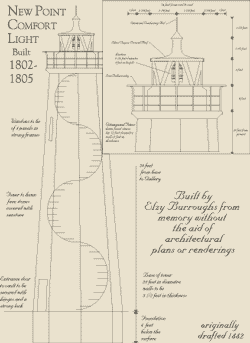 By
the turn of the nineteenth century there was a rapid growth of commerce
in major ports along the Chesapeake Bay. The need for lighthouses became
increasingly apparent. The fixed beacon at Cape Henry marked the entrance
to the bay, and by 1802, the Old Point Comfort light was completed
to help guide ships more safely into the busy ports of Hampton Roads.
Ships traveling North towards Baltimore or Annapolis, however, had
to navigate a course without the aid of lighted beacons. Enveloped
by the darkness of a stormy night they faced mile upon mile of deadly
shoals hidden just below the surface. Mariners complained vigorously
and Congress responded with appropriations to build a third lighthouse
at the tip of the New Point Comfort peninsula in Mathews County, Virginia.
By
the turn of the nineteenth century there was a rapid growth of commerce
in major ports along the Chesapeake Bay. The need for lighthouses became
increasingly apparent. The fixed beacon at Cape Henry marked the entrance
to the bay, and by 1802, the Old Point Comfort light was completed
to help guide ships more safely into the busy ports of Hampton Roads.
Ships traveling North towards Baltimore or Annapolis, however, had
to navigate a course without the aid of lighted beacons. Enveloped
by the darkness of a stormy night they faced mile upon mile of deadly
shoals hidden just below the surface. Mariners complained vigorously
and Congress responded with appropriations to build a third lighthouse
at the tip of the New Point Comfort peninsula in Mathews County, Virginia. 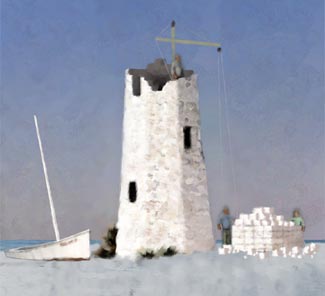 With
the appropriations of $150.00 dollars for the land and $8,500.00 for
construction Burroughs set out in the spring of 1802 to build his second
lighthouse.
With
the appropriations of $150.00 dollars for the land and $8,500.00 for
construction Burroughs set out in the spring of 1802 to build his second
lighthouse. 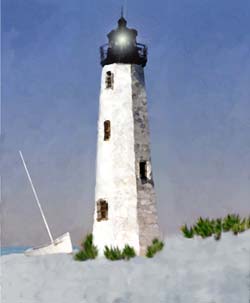 Burroughs
and his men persisted these and other unforeseen difficulties, and
on January 17, 1805 the 63 foot Lighthouse was completed and lit. The
first lantern was an octagon shaped cylinder 6 1/2 feet in diameter
and stood 8 feet tall. Within its light chamber were a series of lamps
suspended by adjustable iron chains. Each lamp was powered by burning
fish, sperm whale, or lard oil. The illuminated beacon could be seen
for up to 12 miles.
Burroughs
and his men persisted these and other unforeseen difficulties, and
on January 17, 1805 the 63 foot Lighthouse was completed and lit. The
first lantern was an octagon shaped cylinder 6 1/2 feet in diameter
and stood 8 feet tall. Within its light chamber were a series of lamps
suspended by adjustable iron chains. Each lamp was powered by burning
fish, sperm whale, or lard oil. The illuminated beacon could be seen
for up to 12 miles. 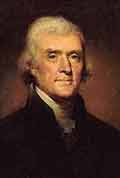 President
Thomas Jefferson personally appointed Elzy Burroughs to be the first
keeper of the light, and he remained there for ten more years. Since
then many keepers have come and gone, some serving for many years while
others could not endure even one. In 1854, James White lasted a mere
3 weeks until his appointment was revoked for reasons that are unknown.
President
Thomas Jefferson personally appointed Elzy Burroughs to be the first
keeper of the light, and he remained there for ten more years. Since
then many keepers have come and gone, some serving for many years while
others could not endure even one. In 1854, James White lasted a mere
3 weeks until his appointment was revoked for reasons that are unknown.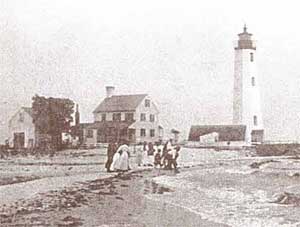 By
the turn of the 20th century the beach around the lighthouse had become
a popular spot for Sunday outings and picnics. Yachting parties came
ashore to enjoy its matchless bathing and camping facilities. "At
most points one can wade a half mile before reaching deep water, at
others deep water is near shore. The water is unusually clear and free
of nettles, making it a fine bathing beach for children as well as
adult swimmers."
By
the turn of the 20th century the beach around the lighthouse had become
a popular spot for Sunday outings and picnics. Yachting parties came
ashore to enjoy its matchless bathing and camping facilities. "At
most points one can wade a half mile before reaching deep water, at
others deep water is near shore. The water is unusually clear and free
of nettles, making it a fine bathing beach for children as well as
adult swimmers."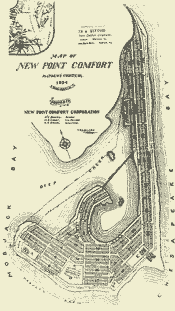 In
1904 a New Point Comfort Development Company was formed with plans
to create a sea side resort on the peninsula. "There isn't a more
attractive spot anywhere on the Atlantic Coast," they said. A
plan was drawn up with the area subdivided into streets with hundreds
of residential lots. There was even to be a grand hotel built near
the lighthouse. The marsh was to be filled and the beaches built up
for the new community. However, when the cost of the project was realized
the business went bankrupt.
In
1904 a New Point Comfort Development Company was formed with plans
to create a sea side resort on the peninsula. "There isn't a more
attractive spot anywhere on the Atlantic Coast," they said. A
plan was drawn up with the area subdivided into streets with hundreds
of residential lots. There was even to be a grand hotel built near
the lighthouse. The marsh was to be filled and the beaches built up
for the new community. However, when the cost of the project was realized
the business went bankrupt.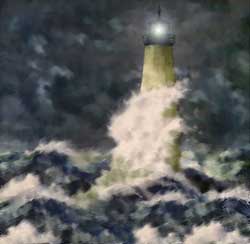 In
August 23, 1933 a great storm descended over the Chesapeake Bay. By
9:00 am. the sky at New Point darkened and torrents of rain began to
fall. As the wind rose out of the southeast to a steady howl the roaring
tide surged nine feet above its usual height drowning the shores of
the tiny island. Wave upon wave in a waste of seething foam was dashed
against the tower. The giant seas reached 12 feet at its peak and cut
a break through the beach. Large swaths of sand were carried away in
the raging whitewater. When the fury had passed the larger island had
been torn from the lighthouse. Boats, fishing equipment, and other
debris were scattered on the beaches and trees uprooted or snapped
in two. All wharves and piers throughout Mathew's County were badly
damaged or completely carried away. Storm waters rushed far inland
reaching depths of 4 feet in the streets around Mathews Courthouse.
At Gloucester Point the town post office and drug store were completely
demolished. Four feet of water stood in the lobby of the Robbins Hotel.
Locations along the Atlantic Coast and Chesapeake Bay incurred epic
destruction from this hurricane costing tens of millions of dollars
in repair.
In
August 23, 1933 a great storm descended over the Chesapeake Bay. By
9:00 am. the sky at New Point darkened and torrents of rain began to
fall. As the wind rose out of the southeast to a steady howl the roaring
tide surged nine feet above its usual height drowning the shores of
the tiny island. Wave upon wave in a waste of seething foam was dashed
against the tower. The giant seas reached 12 feet at its peak and cut
a break through the beach. Large swaths of sand were carried away in
the raging whitewater. When the fury had passed the larger island had
been torn from the lighthouse. Boats, fishing equipment, and other
debris were scattered on the beaches and trees uprooted or snapped
in two. All wharves and piers throughout Mathew's County were badly
damaged or completely carried away. Storm waters rushed far inland
reaching depths of 4 feet in the streets around Mathews Courthouse.
At Gloucester Point the town post office and drug store were completely
demolished. Four feet of water stood in the lobby of the Robbins Hotel.
Locations along the Atlantic Coast and Chesapeake Bay incurred epic
destruction from this hurricane costing tens of millions of dollars
in repair.

